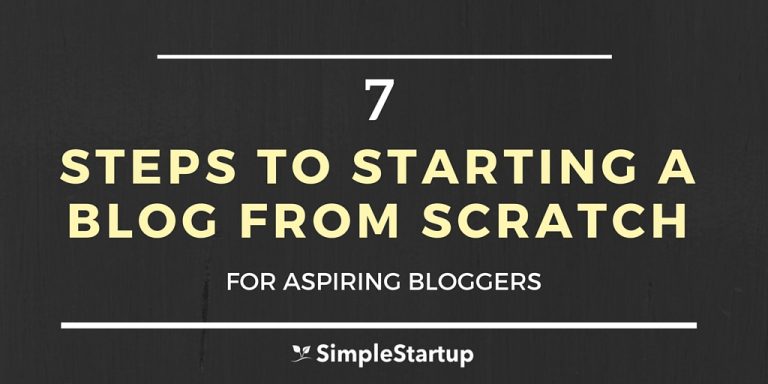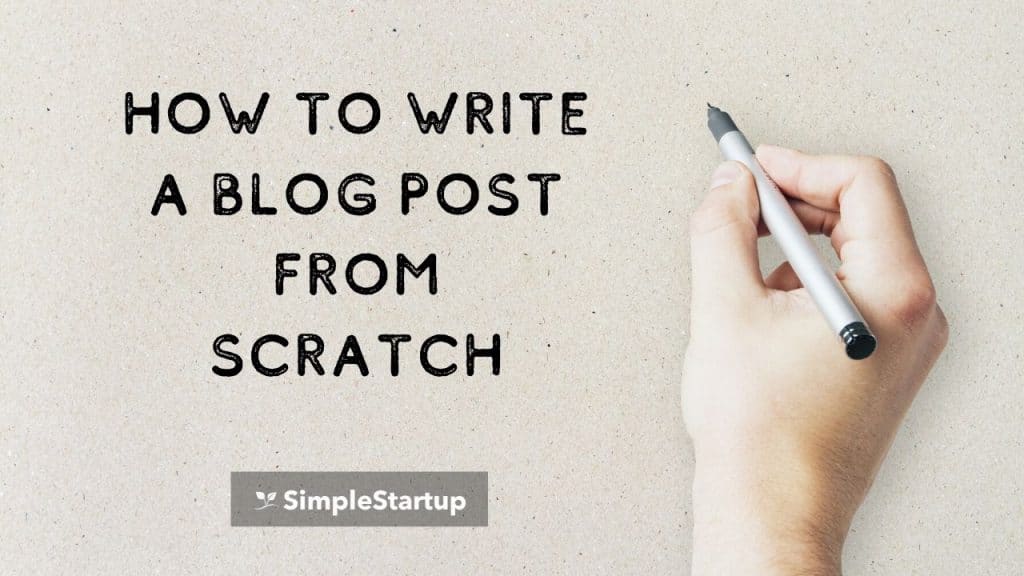
Are you struggling to consistently write good blog posts that attract traffic?
If so, you’re not alone. One of the biggest challenges bloggers face is getting traffic to their blog.
Perhaps you also have a hard time coming up with blog post ideas, performing keyword research and optimizing your posts for SEO.
Whatever the case, I’ll show you how to write your first blog post from scratch so that you’ll start generating more traffic and subscribers.
1. How to generate your first blog post ideas
Coming up with ideas for your first blog posts can be challenging. That’s why it’s important to get inspiration and ideas from external sources.
Every day I’ll listen to podcasts, read blog posts, watch Youtube videos and read books related to my primary topics (blogging, productivity and digital marketing).
By absorbing new information, I’m able to come up with countless ideas for creating blog posts.
You can also use a tool like Buzzsumo or Ubersuggest for getting blog post ideas.
I prefer to use Ubersuggest because it’s free, accurate, user-friendly and you can get really good blog post and keyword ideas quickly.
When you’re logged into Ubersuggest, click on “content ideas” and then type in your keyword. This will fetch up popular blog posts that got lots of shares on Facebook and Pinterest.
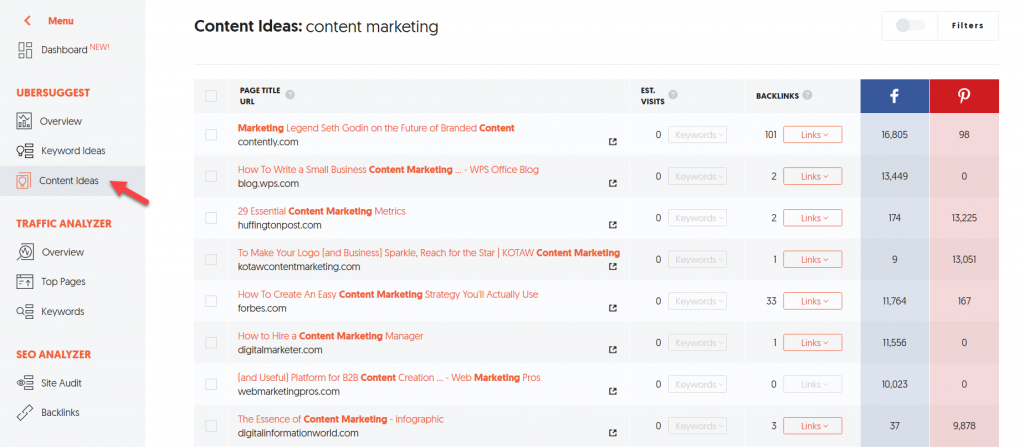
This will show you which articles are in demand and what people are interested in and sharing.
Another way to get ideas is to use Pinterest. Pinterest is a visual search engine that you can use to find good content on a relevant topic.
Login to Pinterest and type in your keyword in the search bar. You’ll see the top results for that topic so that should give you good ideas on what to write about for your blog post.
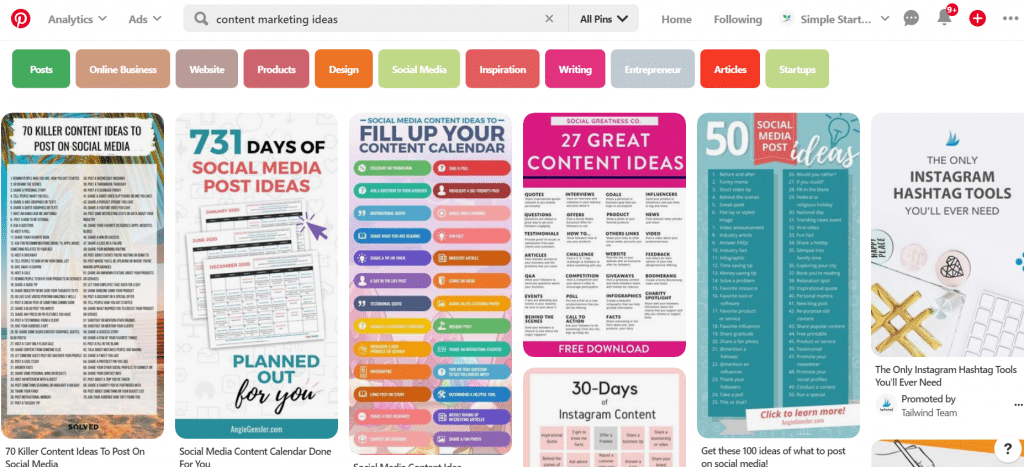
2. Create an outline
Once you know the topic, it’s time to create an outline for your blog post.
If you struggle with “writer’s block”, then starting with an outline is the way to go.
You may not like the idea of outlining an article, but it’s an effective way to get the process started of writing the blog post.
Any time I have an insight or idea for a blog post, I’ll note it down. The tool that I use is called Dynalist. Dynalist which helps you organize your ideas into lists to create an outline.
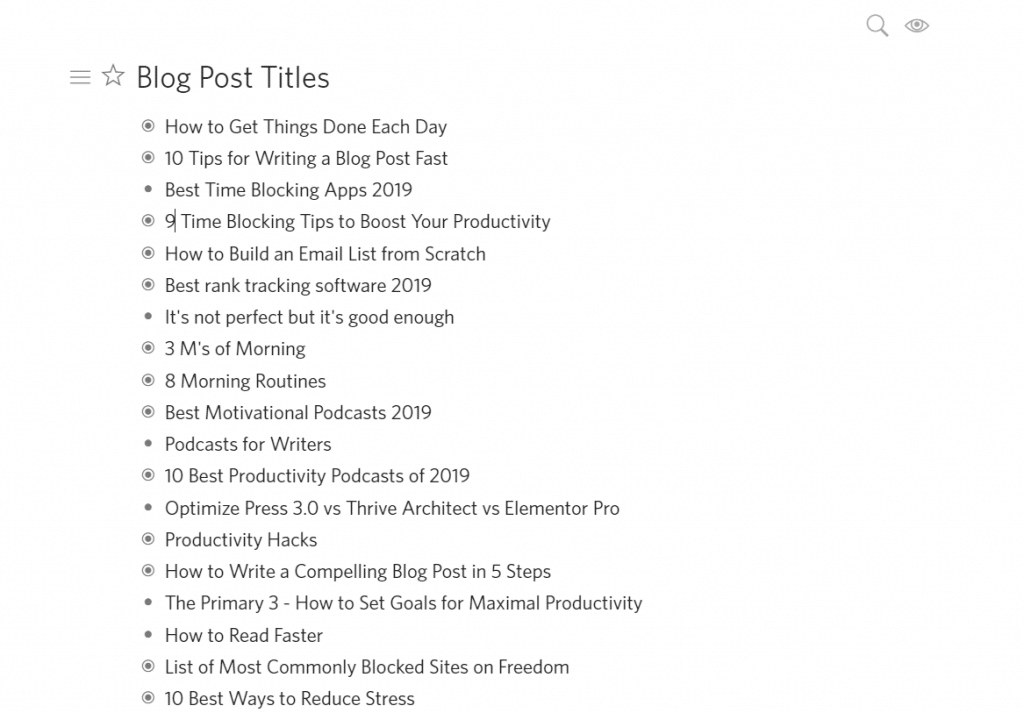
There’s also a mobile app for Dynalist, so if I have an idea while I’m out walking or away from my home office, I’ll note it down in Dynalist app. Then I’ll come home and flesh out the outline by adding the subpoints.
Anytime you have an idea or insight for a post, note it down in Dynalist or your notebook if you prefer writing things down. Then expand on it by adding subpoints for each subhead.
3. Keyword research for bloggers
If you’re not intentional about the keywords that you’re going to use to optimize your blog post, then you’re probably not going to attract as many visitors.
That’s why it’s important to do keyword research for every blog post that you write. I use Ubersuggest for keyword research. For example, if my main keyword for the post is “productivity tips”, then I’ll check whether the keyword is worth targeting in Ubersuggest.
Ubersuggest will give you other suggestions and related keywords based on the seed keyword. You should look for keywords that have good search volume and a low keyword difficulty score (green or light green).
If you target something too broad, like “weight loss” or “diet”, then you’re going to have a difficult time ranking for those head terms.
You want to target long-tail keywords that aren’t as competitive but have moderate search volume. This will, you’ll rank much faster on the first page and you’ll start to see traffic sooner.
It’s better to focus on consistently producing good content for your blog and that gets traffic than to target difficult keywords and spend months and sometimes years optimizing. Sure, you might get a lot of traffic in the long-run, but you could have spent time writing more blog posts and building your email list.
4. Best types of blog posts to create
There are many different types of blog posts that you can create (opinion, news, interviews, etc.), but I’ll list the ones that most profitable bloggers publish on their blogs.
First blog post examples:
List Posts
List posts are one of the best and most common types of blog post types that bloggers create. You’re essentially listing your top tips in a list format for a particular topic in a blog post.
For Simple Startup, I mainly create list post as that’s what gets the most traffic and shares.
For example: “10 Best Ways to Make Money Online in 2019”, “23 Compelling Lead Magnet Ideas to Attract More Subscribers” and “10 Best Productivity Apps for Digital Entrepreneurs in 2019” are list posts.
How-to posts
How to posts are also good for attracting visitors who are looking to get actionable advice and information. They’re also one of the most popular post types that bloggers create regularly.
For example: “How to Lose Weight for Women” and “How to Learn Guitar Fast” are examples of how-to guides.
Ultimate or Definite Guide Posts
If you want to attract a massive amount of backlinks and build domain authority for your website, then it’s a good idea to create ultimate or definite guide posts. These type of posts are usually 3000-5000 words in length.
Brian Dean from Backlinko has a lot of definite guide posts published on his site. For example, he has a post called “Link Building for SEO: The Definite Guide (2019)“. This post is almost 5000 words in length and has 8 chapters.
Review posts
Review posts are a staple for affiliate marketers. By reviewing specific products, you’re showing your visitors if it’s worth it or not to buy the product.
For example, “Kindle Paperwhite 2019 review”.
Case study posts
Case study posts are a great way to documents and share your results with your target audience.
For example, Brian Dean from Backlinko created a case study called, “SEO Case Study: How I Increased My Organic Traffic 652% in 7 Days”. In it he shares his Skyscraper 2.0 technique which helped him get significantly more traffic for his blog posts.
Any time you’ve had good success for yourself or your clients and students, create a case study blog post. Case studies also help build trust with your readers since you’re showing proof of your results.
Original research
Original research can take more time and planning than other types of posts, but they usually get a significant amount of backlinks and shares.
For example, Kyle Byers from Growthbadgers wanted to know how bloggers who earn a high income did things differently from those who didn’t make as much. So he surveyed 1117 bloggers and published the results in a post called, “NEW Blog Statistics 2019: Data from Surveying 1,117 Bloggers (Study)“.
If you’re able to create and publish original research every now and then, it should help boost your overall traffic and domain authority for your blog.
5. How long should a blog post be?
Although there’s no magic word count for a blog post, there’s ways to determine how long should you should make them.
The Growthbadger study showed that the top performing blog posts of bloggers who make at least $50,000/year was 2424 words in length whereas the lower income bloggers had a word count of 1325 words per blog post. Higher income bloggers are also 7 times as likely to have blog posts longer than 3000 words than lower income bloggers.
However, this doesn’t necessarily mean that you should always strive the create 2500-3000+ word blog posts.
A good way to know how long a blog post should be is to check the average word count for the top 10 organic search results for your target keyword.
For example, if you calculate the average word count for the top 10 pages to be 2200 words in length, then you can aim to create a blog post around 2200 words or longer.
It can take a lot of time and energy to create blog posts that are 2000+ words, but if it’s going to get you more traffic and shares in the long run, then it might be worth spending the extra time on each post.
But it’s also important to focus on quality than just quantity. If you can’t write a longer blog post without sacrificing quality, then don’t force writing more for the sake of getting out more words. Always focus on creating high quality content that will resonate with your target audience.
6. How long does it take to write a blog post?
According to a Hubspot study, it can take 1-2 hours to write a 500 word blog post. So if you write a 2000+ blog post, it will likely take 4-8 hours to write.
As you gain more experience writing, you’ll spend less time writing and editing your blog posts. But as I mentioned earlier, it’s important to focus on quality rather than quantity. So if it takes you a lot of time to write a blog post, then don’t fret. You’ll be rewarded with higher engagement by your readers if you don’t rush to finish it and take your time.
7. Write the first draft
Writing the first draft for your blog post can be the most challenging part. That’s where the outline can help you start the process so that you don’t get stuck.
When writing the draft, it’s important not to filter yourself and start editing as you go. It will take more time to write the blog post than if you had just written the draft first. You can edit the post — or send it to your editor — once you’ve completed the draft.
Also, resist the urge to get distracted by other by people or yourself by checking your email, text and social media — or anything else that distracts you. When you switch your attention away from the writing and then come back to it, it leaves an attention residue that can affect the quality of your writing.
Use the outline that you created in Dynalist and paste it into IA Writer or Google Docs. I don’t recommend writing the draft in WordPress because it doesn’t always auto save and you may lose your work if you don’t manually save frequently.
Then set a timer for 25 or 52 minutes, and then write uninterrupted for that time.
Introduction
The introduction is one of the most important sections of your blog post. If you don’t capture the attention of your reader, then you’ll likely lose them and they’ll click the back button.
The first sentence of your blog post can start with a question, quote, stat, or story. The more compelling you can make your first sentence and introduction, the more likely your reader will continue reading.
Subheads
Subheads are the main points for your blog post. Many people will usually skim the blog post and read the subheads before they decide to read it. So it’s important that your subheads are compelling enough to entice your reader to keep reading.
Conclusion
Every blog post should end with a conclusion which is a summary of your post. It can also include a question or call to action for your reader. You can add a content upgrade at the end of every post so that you more people to sign up for your lead magnets.
8. Editing
Once you’ve completed the first draft and hit your target word count, it’s time to start editing.
I’ll usually take at least a day to start editing the article from the day before. This gives my brain time to rest and renew and look at the article with fresh eyes. If you write and edit in a single session, then you may not catch all the minor mistakes and be able to edit with the highest mental clarity. So I recommend editing your blog post the next day.
9. Optimize your page for SEO
Before you publish and start promoting your blog post, you’ll need to optimize your blog for SEO if you want to start getting organic search traffic.
Here’s what you need to optimize:
Optimize your title tag
The title tag is one of the most important factors in terms of on-page SEO. It’s what shows up in the Google search results when people search for a particular keyword.
If you don’t select the right title — and keyword — for your blog post, then you won’t get as much traffic you’d like.
The title of your blog post will be automatically used as the title tag. A good practice is to limit your title tag to 60 characters so that it doesn’t get cut off in the organic search results.
The title of your post is what will capture the attention of your readers. If you don’t have a compelling title, then people won’t click through your email and social media links.
The title should not only get good search volume but also be addressing something that your target audience is interested in
Create a compelling description
The description for your blog post should be compelling enough so that people will click on your search results. Although the description doesn’t directly help with the SEO rankings, it will help improve the click through rates (CTR) which is important.
Create a description for each blog post that’s benefit driven.
Add relevant keywords in body
If you don’t include your primary keywords in the body of the blog post, then you won’t rank as well.
Use primary keyword in your permalink
The permalink is the URL for your blog post. It’s important to use your primary keyword in the URL. You don’t need to include the full title. For example, if the title is “15 BEST Keyword Research Tools for SEO [2019 Reviews]”, the permalink would be: https://backlinko.com/keyword-research-tools, since it’s primary keyword “keyword research tools”.
Optimize your alt tags
Adding alternative text to your images can help with reading accessibility for visitors who can’t see images on your site.
To add “alt text” to your images in WordPress, click on the image and then add the text as shown below:
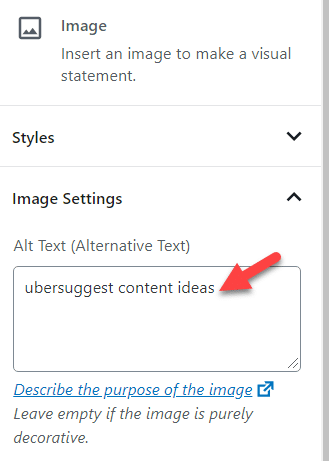
Although it’s good to optimize your alt tags, it’s important not to keyword stuff.
Keep things simple by describing the image as it is without any additional words. It’ll be better for users and search engines.
10. Add a Featured Image
Adding a featured image to your blog post is important since it can help attract 94% more views.
I use Canva to create all my blog post images. To create an image, login to Canva and click on “Create a design” and type in “blog”. Select “blog banner”.
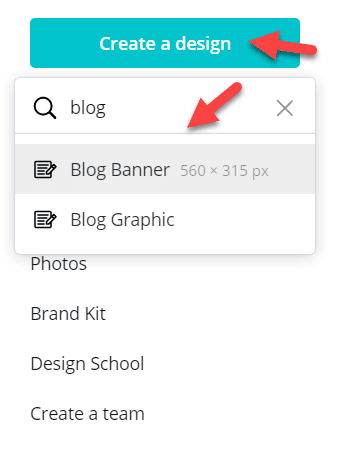
Now you can either create a page from scratch with your own background images, or choose a template.
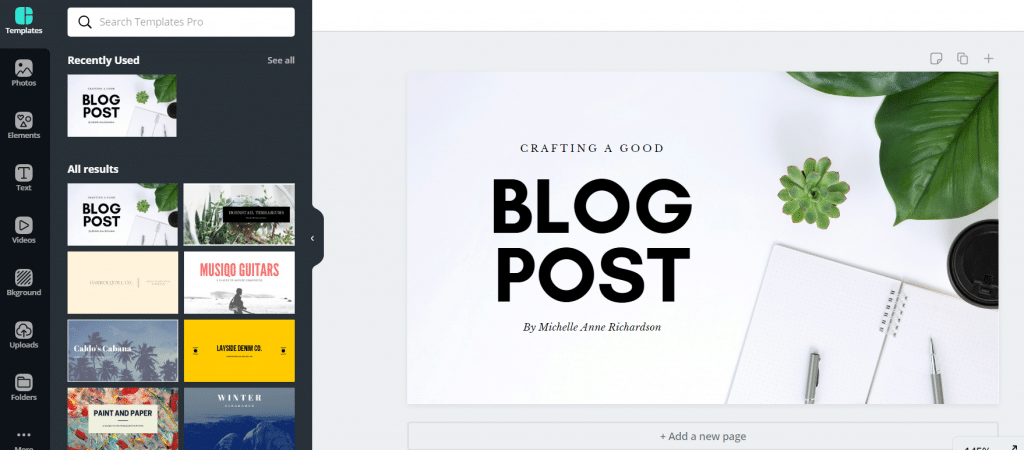
Once you choose or create a template, you can re-use it for other blog posts by replacing the title and/or images.
Once you’re done modifying the image in Canva, download it to your computer and then upload it to WordPress. Add the image underneath your header and to the featured image section as below:
11. Choose a relevant category
It’s also important to choose the right category for your blog posts. For example, I have at least 8 primary categories that I write about on Simple Startup (productivity, blogging, online business, sales funnels, SEO, content marketing, social media marketing, and email marketing).
When you’re starting, pick 4-6 categories that you can write about. Then, before you publish the post, select the relevant category. This will make sure that all your articles are organized well on your website and your visitors will be able to find the relevant information by searching for those categories.
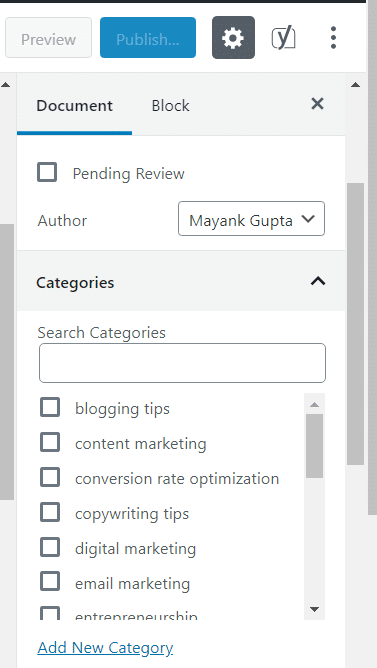
12. Digital Marketing
Once you’ve hit publish, it’s not the end of the road. If you want to start attracting traffic fast, then you’ll need to share your post on social media platforms like Twitter, Pinterest.
Once the post is live, you can use a tool like social media tool like Buffer to queue to schedule the post to be shared on your primary social media networks.
Make sure to use the proper hashtags for each post so that you get the most amount of engagement and sharing of your posts.
Conclusion
Writing your first blog post isn’t easy, but by following the steps and advice in this article, you should be able to create a post that gets more traffic, shares and subscribers.

